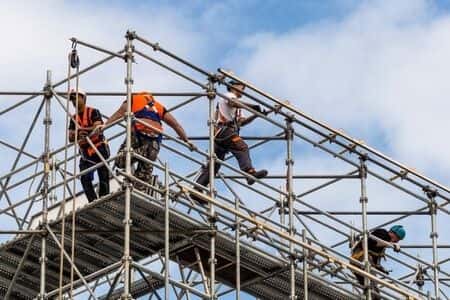Certified Safety Expert Discusses Severe Injuries Suffered by Welder on Scaffolding
Updated on
This case involves a pair of union ironworkers who were working on a project to restore the interior of a historical building in a large northwestern city. At the time of the incident in question, the workers were using a large scaffolding to access the exterior of a decorative iron railing on a large interior staircase. The two workers, along with several others at the job site, were involved in extensive welding and burning work. Fumes and smoke from the work had been causing them to experience respiratory distress along with eye irritation, and the two workers brought a commercial blower up the scaffolding with them in order to clear the fumes and smoke. On the date of the incident in question, one of the workers accidentally knocked the blower off of the scaffolding. The blower then fell on a worker on a lower level of the scaffolding, causing serious injuries.
Question(s) For Expert Witness
1. Is there a system to exhaust the fumes from the cutting rather than having ironworkers bringing their own equipment onto the scaffolds?
Expert Witness Response E-008566
 I have 30+ years of experience as a safety professional, working with hundreds of contractors. I am a Certified Safety Professional with an emphasis in construction safety and management. I currently serve as an adjunct faculty member in the Safety Studies program at a major state university. OSHA regulations, relevant consensus standards, and industry custom and practice all dictate that adequate measures must be taken to prevent the unsafe accumulation of fumes during welding and cutting operations. The related standards are performance-based, meaning that they do not necessarily dictate the means and methods of control, but simply define the level of control which must be maintained. The use of general ventilation is one common method to achieve the desired result. There are certainly applicable guidelines regarding the placement and removal of tools and equipment onto scaffolding. These rules are intended to ensure that the equipment is handled in a safe manner. An employee manually carrying a large blower onto or removing it from scaffolding would be wholly unacceptable.The responsibility of the general contractor and the employer is determined and defined by a number of factors, many of which are unique to each site. Contractual requirements, statutory requirements (i.e. OSHA), adherence to consensus standards, and custom, practice, and expectations all must be duly considered.
I have 30+ years of experience as a safety professional, working with hundreds of contractors. I am a Certified Safety Professional with an emphasis in construction safety and management. I currently serve as an adjunct faculty member in the Safety Studies program at a major state university. OSHA regulations, relevant consensus standards, and industry custom and practice all dictate that adequate measures must be taken to prevent the unsafe accumulation of fumes during welding and cutting operations. The related standards are performance-based, meaning that they do not necessarily dictate the means and methods of control, but simply define the level of control which must be maintained. The use of general ventilation is one common method to achieve the desired result. There are certainly applicable guidelines regarding the placement and removal of tools and equipment onto scaffolding. These rules are intended to ensure that the equipment is handled in a safe manner. An employee manually carrying a large blower onto or removing it from scaffolding would be wholly unacceptable.The responsibility of the general contractor and the employer is determined and defined by a number of factors, many of which are unique to each site. Contractual requirements, statutory requirements (i.e. OSHA), adherence to consensus standards, and custom, practice, and expectations all must be duly considered.
About the author
Joseph O'Neill
Joe has extensive experience in online journalism and technical writing across a range of legal topics, including personal injury, meidcal malpractice, mass torts, consumer litigation, commercial litigation, and more. Joe spent close to six years working at Expert Institute, finishing up his role here as Director of Marketing. He has considerable knowledge across an array of legal topics pertaining to expert witnesses. Currently, Joe servces as Owner and Demand Generation Consultant at LightSail Consulting.
Subscribe to our newsletter
Join our newsletter to stay up to date on legal news, insights and product updates from Expert Institute.
Sign up nowFind an expert witness near you
What State is your case in?
Subscribe to our newsletter
Join our newsletter to stay up to date on legal news, insights and product updates from Expert Institute.



